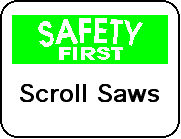When I look over the new scroll saws
memories always come back to me of the first one that I had.
My father made it for me, he built it around an old Briggs
and Straton engine, took the head off, drilled a hole in the
piston and put a stubby shaft with a slot on it to hold the
blade. The table was a disk from a grain seed drill, the top
spring to tension the blade was from an old mattress. I got
hours of pleasure from this tool, it was what got me started
in woodworking. In those days I knew nothing of variable
speeds, sawdust blowers, hold downs, C - arms, spiral or
reverse blades. Scroll sawing is an easy hobby to get
started in, the saw runs quiet enough so as not to disturb
the neighbours, it does not require a large investment in
equipment nor require a large work space. Best of all it is
a relatively safe hobby, injuries may happen but are minor
compared to what can happen with other woodworking
equipment. Choose a saw that feels comfortable to
you, many hours will be spent in front of it. The table
should be large enough to support the material both in front
of the blade and behind it, the controls should be convient
to reach and easy to set. The blower should be powerful
enough to remove sawdust even when set far enough above the
material so you can clearly see the cutting lines. The saw
should run smoothly, if it has excess vibration your hands
will become fatigued very quickly.


Blades
Scroll Blades (Shown on the left) are
recommended for cutting thicker and harder
material. Spiral Blades (Shown 2nd from the left)
blades are twisted so teeth point outward in every
direction. A 360° capacity allows cutting in any
direction without turning your work. Reverse Blades (Shown 2nd from right)
Teeth are pointed in both directions to give splinter free
cutting on the top and bottom.

Accessories


Links
Books with Tips and Techniques
